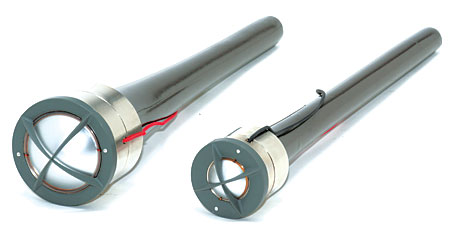| Columns Retired Columns & Blogs |
Dickie? Vivid? Is this a porn double entendre?
Part of this, again, was the effortless way the G1Giyas had with dynamics—against Hassell's restrained (and muted) trumpet, Terrasson's piano constantly leaps between foreground and background. His syncopated accompaniment kept startling me with its facile jumps and emphases. I shouldn't have been surprised—after all, one experiences this all the time with live music, even acoustic duets, but recorded sound frequently smooths out those dynamic peaks and valleys. Not so through the G1Giyas.

Another immense soundscape was presented by "Tea Leaf Prophecy," from Herbie Hancock's River: The Joni Letters (Verve, 24/96 FLAC download, HDtracks). Drummer Vinnie Colaiuta's brushwork sounded anchored in the recording space, Dave Holland's acoustic bass was extended and concrete, while Hancock's piano filled all the spaces between the other instruments, creating a three-dimensional construct that was sonically compelling. And then there was Mitchell's husky voice, now almost a tenor thanks to age and cigarettes (I don't mean that as a putdown; she's more in control of her instrument than ever, I think). But what made me jump, every time, was how present and—I keep returning to this word—lifelike Wayne Shorter's soprano saxophone sounded.
Ezra Pound said that "literature is news that stays news." The Vivid G1Giya reinforced that his statement is just as true of great music.
Memories so real and vivid
During the G1Giyas' stay in my system, the only other Class A speakers also visiting were Thiel's CS3.7s. One might justifiably claim that comparing the $12,900/pair Thiels to the $65,000/pair Vivids is inherently unfair, but the CS3.7s are listed in Class A (Limited Extreme LF) of Stereophile's "Recommended Components," and I did say in my review of them in the December 2008 issue that I loved them. So, of course, I was cruel to them.
Playing "The Wardrobe Master of Paradise," the Thiels delivered a smaller soundstage than the Vivids, albeit one still perfectly formed. The G1Giya's bass was more extended, and the Haitian drummers had greater jump factor.
The Thiels toned down the gawpy stomp of the Kinks' "Ducks on the Wall," but only by a bit. I speculate that this might have more to do with the original recording quality of A Soap Opera than anything else—a speaker can't reproduce what never made it onto the tape. The G1Giyas did go a tad deeper, and Dave Davies' guitar may have had a bit more of the buzz saw to it, but the difference wasn't immense.
Not so with Hassell's "Suite de Caravan," however. Again the Thiels reduced the size of the soundstage, especially the vertical dimension. Dynamic contrasts, while quite good, were not as lifelike through the Thiels as through the Giyas—and this is precisely one of the qualities I most admired about the CS3.7, and still do. Terrasson's piano sounded more in the same plane as Hassell's trumpet than it did through the Vivids.
And that was pretty much the story with "Tea Leaf Prophecy," as well. Compared to the G1Giyas, the Thiels reduced both the scale of the soundstage and the instruments' timbral richness.
At some point in such comparisons, I always ask myself if the differences are night-and-day—or is one speaker right and the other wrong? I respond unequivocally: Yes and no. Were the Vivids, in my opinion, better than the Thiels? Yes. Were the Thiels wrong? No. I thought they were great speakers and a value in 2008, and I still think so.
But I also think that anyone hearing both loudspeakers would prefer the Vivid G1Giyas—assuming that price didn't matter.
Receive them in a vivid imagination
Aye, there's the rub. Price is always a consideration, innit? Considering the proprietary (and therefore costly) technology that has gone into Vivid's G1Giya's cabinet and drivers, I suspect that $65,000/pair is a fair price—meaning that I suspect Vivid is taking a smaller profit margin than is the norm in high-end audio. Does that make them a bargain? No.
On the other hand, I've heard some extremely expensive speakers, costing two and even three times the Vivids' price, that can do one or two of the things the G1Giyas do so well. But I can't think of any speaker I've auditioned that does everything as well as the Giyas: superb imaging, unmatched dynamic range, holographic soundstaging, and that immutable, possibly unquantifiable quality known as musicality.
Is Vivid Audio's G1Giya the best loudspeaker I've ever heard? Yes. And it will be my yardstick from now on. Whether or not you can afford a pair, you should listen to them so that you know exactly what is possible in a high-end loudspeaker.

Dickie? Vivid? Is this a porn double entendre?